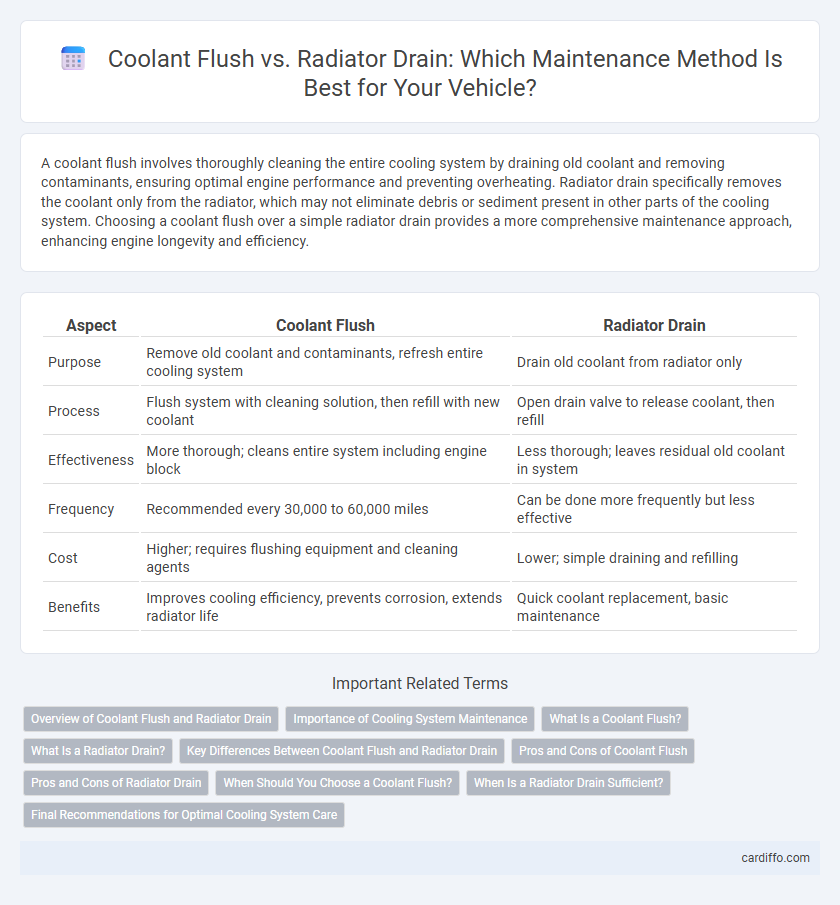A coolant flush involves thoroughly cleaning the entire cooling system by draining old coolant and removing contaminants, ensuring optimal engine performance and preventing overheating. Radiator drain specifically removes the coolant only from the radiator, which may not eliminate debris or sediment present in other parts of the cooling system. Choosing a coolant flush over a simple radiator drain provides a more comprehensive maintenance approach, enhancing engine longevity and efficiency.
Table of Comparison
| Aspect | Coolant Flush | Radiator Drain |
|---|---|---|
| Purpose | Remove old coolant and contaminants, refresh entire cooling system | Drain old coolant from radiator only |
| Process | Flush system with cleaning solution, then refill with new coolant | Open drain valve to release coolant, then refill |
| Effectiveness | More thorough; cleans entire system including engine block | Less thorough; leaves residual old coolant in system |
| Frequency | Recommended every 30,000 to 60,000 miles | Can be done more frequently but less effective |
| Cost | Higher; requires flushing equipment and cleaning agents | Lower; simple draining and refilling |
| Benefits | Improves cooling efficiency, prevents corrosion, extends radiator life | Quick coolant replacement, basic maintenance |
Overview of Coolant Flush and Radiator Drain
Coolant flush involves removing old coolant, cleaning the entire cooling system, and refilling with fresh coolant to eliminate contaminants and prevent overheating. Radiator drain simply empties the radiator, often leaving residual debris and old coolant in the system, which may reduce cooling efficiency. Regular coolant flushes extend engine life by maintaining optimal temperature regulation and corrosion protection.
Importance of Cooling System Maintenance
Regular cooling system maintenance prevents engine overheating and extends vehicle lifespan by ensuring optimal thermostat and radiator performance. Flushing the coolant removes contaminants and corrosion, maintaining proper heat transfer and preventing clogs or radiator damage. Draining the radiator alone often fails to eliminate buildup, risking coolant degradation and reduced engine efficiency over time.
What Is a Coolant Flush?
A coolant flush involves completely removing old coolant from the entire cooling system, including the radiator, engine block, and heater core, and replacing it with fresh antifreeze and water. This process helps eliminate rust, scale, and other contaminants that can clog the cooling system, improving engine performance and preventing overheating. Unlike a simple radiator drain, a coolant flush thoroughly cleans the entire system to maintain optimal cooling efficiency.
What Is a Radiator Drain?
A radiator drain is a valve or plug located at the bottom of a vehicle's radiator, designed to allow the coolant to be easily expelled during maintenance. This component facilitates the removal of old coolant, debris, and contaminants, ensuring the cooling system remains clean and functions efficiently. Performing a radiator drain is essential for preventing overheating and maintaining optimal engine temperature regulation.
Key Differences Between Coolant Flush and Radiator Drain
A coolant flush involves completely removing old coolant and contaminants from the entire cooling system, ensuring optimal engine temperature regulation and preventing corrosion. In contrast, a radiator drain only empties the coolant from the radiator, leaving leftover coolant and deposits in engine passages and the heater core. Coolant flushes provide a more thorough maintenance, while radiator drains are quicker but less effective in removing buildup and maintaining engine cooling efficiency.
Pros and Cons of Coolant Flush
A coolant flush effectively removes old antifreeze, rust, and debris from the entire cooling system, enhancing engine performance and preventing overheating. However, the process carries risks like damaging sensitive components if performed improperly or using the wrong chemicals. Regularly scheduled flushes improve heat transfer efficiency but may be unnecessary for vehicles with modern long-life coolants, making a radiator drain a simpler, less invasive alternative.
Pros and Cons of Radiator Drain
Radiator drain offers a quicker method to remove old coolant, minimizing labor time and reducing fluid waste compared to a full coolant flush. However, this method may not entirely clear accumulated sludge or contaminants from the cooling system, potentially leading to reduced efficiency and overheating issues. Choosing radiator drain can be cost-effective for routine maintenance but might require supplemental flushing to ensure optimal engine cooling performance.
When Should You Choose a Coolant Flush?
A coolant flush should be chosen when the vehicle exhibits signs of overheating, coolant contamination, or corrosion buildup inside the radiator and cooling system. Performing a coolant flush every 30,000 to 50,000 miles helps maintain optimal engine temperature and prevents damage to critical components such as the water pump and thermostat. Unlike a simple radiator drain, a full flush removes sludge, rust, and old coolant, ensuring the entire cooling system is thoroughly cleaned for improved efficiency and longevity.
When Is a Radiator Drain Sufficient?
A radiator drain is sufficient when performing a basic coolant replacement or routine maintenance that does not require complete system flushing. It effectively removes old coolant from the radiator but may leave residual contaminants in the engine block and heater core. For systems with significant buildup or overheating issues, a full coolant flush is recommended to ensure thorough cleaning and optimal cooling system performance.
Final Recommendations for Optimal Cooling System Care
For optimal cooling system care, a coolant flush is recommended every 30,000 to 50,000 miles to remove rust, debris, and old antifreeze, ensuring efficient heat transfer and extended radiator life. Radiator drain alone only removes the old coolant but leaves contaminants that can build up, leading to overheating and corrosion over time. Regular coolant flushes combined with timely radiator inspections provide the best preventative maintenance for engine temperature regulation and long-term system reliability.
Coolant Flush vs Radiator Drain Infographic

 cardiffo.com
cardiffo.com